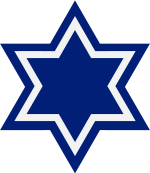2nd Infantry Regiment (South Korea)
| 6th Infantry Division | |
|---|---|
 |
|
| Active | November 20th, 1948 - present |
| Country |
|
| Branch |
|
| Type | Infantry |
| Role | Zone defense |
| Part of | 5th Corps(Republic of Korea) |
| Nickname(s) | "Blue Star" |
| Battle honours | Korean War |
| Commanders | |
| Notable commanders |
Lt. Col. Lee Hyong Kun |
The 6th Infantry Division was a military formation of the Republic of Korea Army during the 20th Century.
The Division initially consisted of the 2nd, 7th, and 19th Regiments.
The 2nd Infantry Regiment was originally activated as the 2nd Regiment on February 28, 1946 at Taejon and was first commanded by Lt. Col. Lee Hyong Kun. The unit was initially assigned to the 1st Brigade in December 1947 and was later reassigned to the 6th Division when it was activated in May 1949.
The division became part of II Corps after the first fall of Seoul. Was part of the defensive line to slow the North Korean advance from Seoul to Taejon.
Fought in the Battle of Pusan Perimeter.
The 6th Division, meeting little opposition and traveling fast up the Chongchon River valley, reached Huichon, nearly sixteen miles north of Kujang-dong, on the night of October 23, 1950. Passing through Onjong, twenty-six miles from Huich'on, during the night of the twenty-fourth, the 7th Regiment, 6th Division, turned north and advanced toward Chosan, fifty miles away on the Yalu River. A reinforced reconnaissance platoon from the 7th Regiment entered Chosan the next morning and found the North Koreans retreating across the Yalu into China over a narrow floating footbridge.
On October 25, in the ROK II Corps sector, the 3d Battalion, 2d Regiment, 6th Division, started northwest from Onjong, about fifty miles from Yalu River, toward Pukchin. Eight miles west of Onjong the 3d Battalion encountered what was thought to be a small force of North Koreans but was, in reality, a Communist Chinese forces (CCF) trap, in which CCF troops destroyed the 3d Battalion as an organized force. On the evening of the next day the division ordered its 7th Regiment to withdraw south. Before it could do so, however, it needed supplies, which were airdropped on the twenty-eighth. As the 7th Regiment headed south the following morning, it ran into an enemy roadblock about twenty miles south of Kojang.
...
Wikipedia
